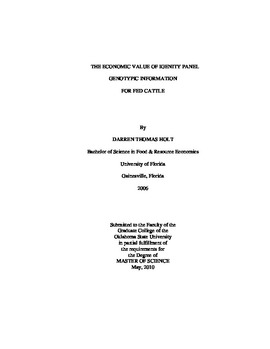| dc.description.abstract | Cattle phenotypes are determined by management and genetics. Beef carcass marbling, tenderness, weight, and fat content are economic traits that are affected by these factors. Economically-relevant traits are typically influenced by numerous genetic markers. Hence, genetics determine, in part, the profitability of fed cattle. Genetic testing companies, such as Merial Igenity, have made it easier for cattle operators to make selection and management decisions through marker assisted selection. This study determined the economic value of genotypic information from the Merial Igenity panels for fed cattle. A sample of 2201 head of fed steers and heifers were used to estimate a profit function with days-on-feed, placement weight, placement age, Igenity panels, sire and dam breeds, and source as independent variables. As days-on-feed and placement weight may be influenced by Igenity panel markers, separate equations were estimated with Igenity panels as independent variables. Using the estimated models of profit, days-on-feed, and placement weight, total marginal effects were found by totally differentiating the profit function and substituting in estimated coefficients from the regression models. Prices for fed cattle, quality and yield grade premiums and discounts, and hot carcass weight were varied over a range of values to assess the sensitivity of estimated effects of Igenity panels on profit. The Igenity panel scores for marbling and average daily gain had a significant and positive impact on fed cattle profits. With average grid prices, cattle operators could expect to gain 3.96 for each additional increase in Igenity marbling score and 6.26 for each additional increase in Igenity average daily gain score. Other Igenity panel information such as yield grade, ribeye area, tenderness, and residual feed intake should not be overlooked. Although, their marginal profitability was lower and varied in sign, they require more analysis to understand their impact on the value of fed cattle. | |
